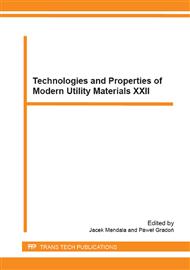p.3
p.7
p.11
p.17
p.23
p.29
p.33
p.39
The Origin of the Ferroelectricity in the Bismuth Titanate Bi4Ti3O12 with Perovskite-Like Layered Structure
Abstract:
The goal of this study was to investigate the origin of ferroelectricity in Bi4Ti3O12. The bismuth titanate Bi4Ti3O12 (BTO), which belongs to the Aurivillius family, is one of the most interesting compounds among the bismuth-based layered ceramics. BTO is a ferroelectric material with wide applications in the electronic industry, as capacitors, transducers, memory devices and sensors. Aurivillius structures are described with a general formula following form:Am-1Bi2BmO3m-1. BTO ceramic materials is an Aurivillius structure with m = 3. This ceramic materials were prepared by conventional mixed-oxide method of the solid state reaction. The temperature of the Bi4Ti3O12 sintering was selected on basis of thermogravimetric studies. The crystal structure of Bi4Ti3O12 was examined at room temperature with an X-ray diffraction method. Phase formation behavior was investigated using the differential thermal analysis (DTA) and the thermal gravimetric (TG). The microstructure was investigated by SEM method. Based on the Dorrian’s model, the value of displacements between bismuth ions and oxygen octahedra was calculated.
Info:
Periodical:
Pages:
17-22
Citation:
Online since:
January 2015
Authors:
Price:
Сopyright:
© 2015 Trans Tech Publications Ltd. All Rights Reserved
Share:
Citation:


